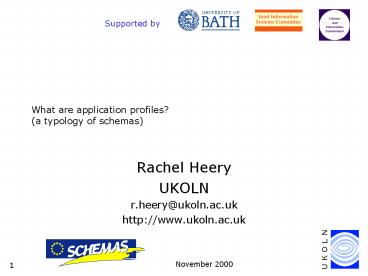Rachel Heery - PowerPoint PPT Presentation
1 / 20
Title:
Rachel Heery
Description:
(a typology of schemas) Supported by. November 2000. 2. Problem area ... To establish a new service or system implementor must decide on appropriate metadata schema. ... – PowerPoint PPT presentation
Number of Views:43
Avg rating:3.0/5.0
Title: Rachel Heery
1
What are application profiles? (a typology of
schemas)
- Rachel Heery
- UKOLN
- r.heery_at_ukoln.ac.uk
- http//www.ukoln.ac.uk
2
Problem area
- Metadata is required in order to manipulate or
manage resources - Metadata is pervasive on the web
- To establish a new service or system implementor
must decide on appropriate metadata schema.. But
which one? - Implementors want to re-use existing schema where
appropriate
3
Project requirements
- Re-use effort
- Align to inter-working systems
- What schemas exist?
- What schemas are used by similar systems?
- Is this schema current?
- How is it used?
4
Implementors will typically
- Choose subset(s) of existing schema
- Add variety of local extensions to standard
schema - Customise definitions
- Establish local good practice
- formulate rules for content
- specify schemes
5
Emerging schemas
- DC-education
- EULER
- EIONET
- MathNet
- RSLP collection description
- http//www.ukoln.ac.uk/metadata/slp/schema/
6
DC-Education proposal
- DC elements and recommended DC qualifiers
- DC-education extensions
- audience mediator
- standard identifier, version
- (DC relation) conforms to
- IEEE LOM IMS elements
- TypicalLearningTime
- InteractivityLevel
7
RSLP Collection Description schema
- dctitle The name of the collection
- dc identifier A formal identifier for the
collection - dcdescription A description of the collection
- cldstrength An indication (free text or
formalised) of the strength(s) of the collection - cldaccessControl A statement of any access
restrictions placed on the collection including
allowed users, charges etc - .
- ...
8
What is happening in practice
- Implementors are-
- selecting from other metadata sets
- extending existing element sets
- refining definitions
- mandating schemes
9
Data model
- Namespace
- schema
- Elements declared
- Elements defined
- Means of declaring
- new elements
- Application
- profile
- Re-uses elements from
- namespace schema
- Means of declaring what application understands
10
What do we mean by namespace
- Namespace is an identified element set with
agreed vocabulary - By means of namespace we can
- Identify registration authority
- Support definition of unique identifiers for
elements - Define particular data element sets or
vocabularies
11
Types of schema
- Namespace schema
- Standard element set
- (defined function)
- One registration authority
- Self reliant
- IEEE LOM/IMS
- Dublin Core
- MARC 2000
- indecs
- and so on
- Application profiles
- Mix and match
- (optimised for application)
- One or more registration authorities
- Draws from elsewhere
12
Characteristics of schemas
International standard schemas
Implementation specific schemas
Single namespace
Multiple namespaces
13
Application profile -definition
- Schema consisting of data elements drawn from one
or more namespaces optimised for a particular
local application - Draws on existing namespaces and introduces no
new data elements
14
Application profile requirements
- Should allow implementor to declare
- limited set of existing elements
- an element is mandatory
- particular schemes must be used with a
particular element - a customised definition of an element from
existing namespace - rules for content (usage guidelines)
15
Publishing schemas and application profiles
- Why?
- To inform and promote
- To provide authoritative version
- To facilitate inter-working
- To align with other schemas
- How?
- Common syntax
- RDF schemas
- XML schemas
16
Schema Registries
Registry
Registry
Registry
- Registry provides access to collection of schemas
- Adds value by providing services
- search, browse
- crosswalks and mappings
- links to sample metadata instances
- links to annotations
- links to implementations
17
Thick registry
Namespace schema
App profile
Mapping
Thick Registry
Sample data
Usage guide
Software tools
Users
18
Thin registry
Namespace schema
App profile
Mapping
Sample data
Usage guide
Thin Registry
Software tools
Users
19
SCHEMAS registry
- Prototype thin HTML registry (on web site now)
- Prototype thick RDF Registry will contain
- Application profiles
- Namespace schemas
- Metadata activity reports
- Standards activity reports
- Expert reviews
20
Benefits of common approach
- Re-use existing work where appropriate
- Common tools
- Good metadata management
- Economies of scale
- Effective interworking between services































